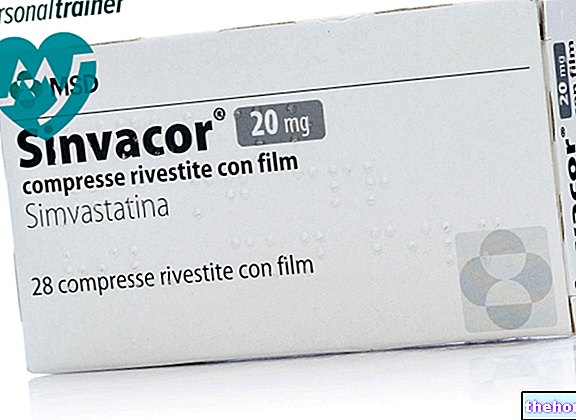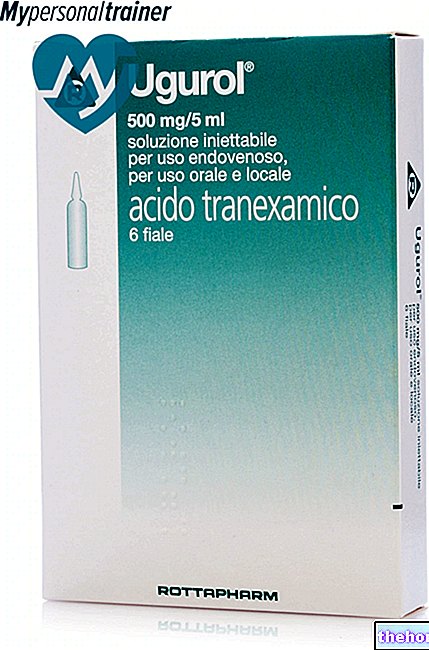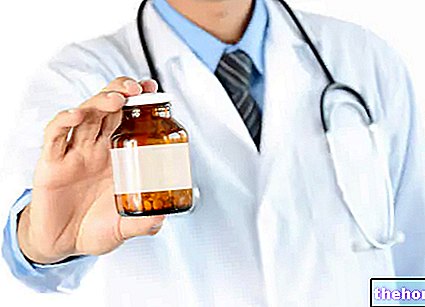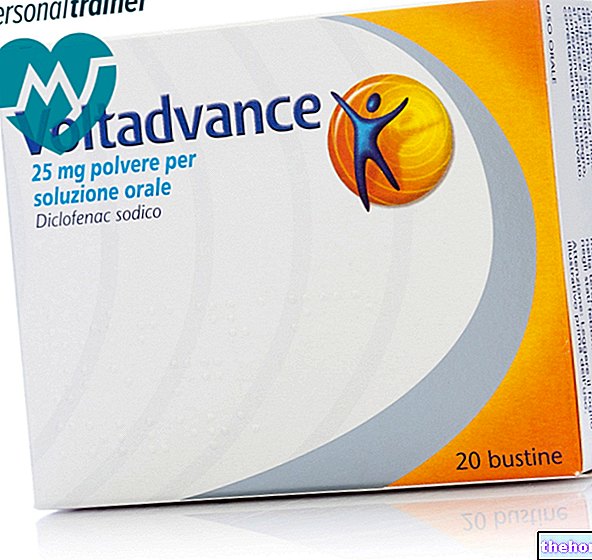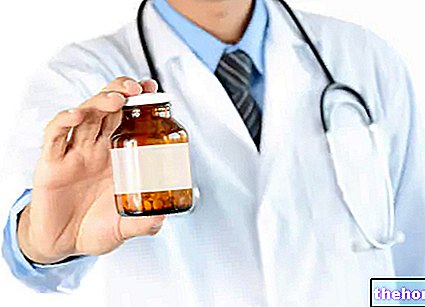Active ingredients: Paracetamol, Chlorphenamine (Chlorphenamine maleate)
BABY RINOLO C.M. 2.4 g / 100 ml + 0.015 g / 100 ml syrup
Why is Baby rinolo used? What is it for?
BABY RINOLO C.M. is a medicine that contains 2 active ingredients: paracetamol, which is a pain reliever and antipyretic (lowers fever), and chlorphenamine maleate, which is an antihistamine.
BABY RINOLO C.M. it is used in combination with other medicines (adjuvant treatment), in case of:
- fever associated with disorders of the nose or throat (upper respiratory tract);
- inflammation of the nasal passages (acute and subacute sinusitis).
Contraindications When Baby rinolo should not be used
Do not use BABY RINOLO C.M. self:
- you are allergic to paracetamol and chlorphenamine or any of the other ingredients of this medicine (listed in section 6);
- has an "age less than 3 years;
- have had symptoms due to a disease known as favism or bean disease, which causes a decrease in red blood cells (insufficiency of glucose-6-phosphate dehydrogenase);
- suffer from haemolytic anemia, a disease that destroys red blood cells;
- have severe liver problems (hepatobiliary insufficiency);
- have severe heart problems;
- have an obstruction of the stomach or intestines (pyloro-duodenal obstruction);
- suffer from bronchial asthma.
Precautions for use What you need to know before taking Baby rinolo
Talk to your doctor or pharmacist before using BABY RINOLO C.M. self:
- has "increased thyroid function (hyperthyroidism);
- have diabetes;
- have heart problems;
- have kidney problems (kidney failure);
- little urine (urinary retention);
- have liver problems (liver failure);
- suffer from epilepsy.
During treatment with paracetamol, before taking any other drug, check that it does not contain the same active ingredient, as if paracetamol is taken in high doses, serious side effects can occur. Your doctor will monitor your respiratory function while you are being treated with paracetamol.
Interactions Which drugs or foods can modify the effect of Baby rinol
Tell your doctor or pharmacist if you are taking, have recently taken or might take any other medicines.
Do not use BABY RINOLO C.M. with other medicines that contain paracetamol or that reduce fever and pain.
This is especially important if you are taking:
- antidepressants (medicines used for depression) such as tricyclics and monoamine oxidase inhibitors (MAOIs);
- sedatives such as barbiturates; ? neuroleptics (medicines used against psychosis);
- anti-inflammatories such as indomethacin (used to treat rheumatic diseases);
- antivirals (medicines used to treat diseases caused by viruses) such as zidovudine;
- anxiolytics (medicines used for anxiety);
- hypnotics and sedatives (medicines that induce sleep);
- opioids and NSAIDs (medicines used for pain relief);
- cholestyramine (used to lower blood cholesterol);
- metoclopramide (used to treat nausea and vomiting);
- anticoagulants (medicines that delay blood clotting) such as warfarin or other coumarins;
- antiepileptics (medicines used to treat epilepsy) such as glutethimide, phenobarbital, carbamazepine;
- rifampicin and isoniazid, antibiotics used to treat tuberculosis (a disease of the lungs);
- cimetidine (medicine used to treat peptic ulcer (a lesion of the stomach);
- probenecid (medicine used in gout).
Warnings It is important to know that:
BABY RINOLO C.M. contains:
- sucrose and sorbitol. If you have been told by your doctor that you have an intolerance to some sugars, contact your doctor before taking this medicinal product;
- sodium metabisulfite. Rarely it can cause severe hypersensitivity reactions and bronchospasm;
- methyl-para-hydroxybenzoate and propyl-para-hydroxybenzoate. They can cause allergic reactions (even delayed);
- ethanol. This medicine contains small amounts of ethanol (alcohol) less than 100 mg per dose.
For those who carry out sporting activities, the use of medicines containing ethyl alcohol can determine positive doping tests in relation to the alcohol concentration limits indicated by some sports federations.
Dose, Method and Time of Administration How to use Baby rinolo: Posology
Always use this medicine exactly as your doctor has told you. If in doubt, consult your doctor or pharmacist.
Children over 3 years of age who weigh more than 6 kg
The recommended dose is calculated based on the child's weight:
- from 6 to 10 kg: 2.5 ml every 4 hours;
- from 10 to 20 kg: 5 ml every 6 hours;
- over 20 kg: 5 ml every 4 hours.
Do not administer to children under three years of age or for more than five days.
Method of administration
BABY RINOLO C.M. must be taken by mouth (orally) To avoid stomach upset, take this medicine after meals.
To take the correct dose:
- Open the bottle by pressing and turning the cap at the same time
- Use the 2.5ml, 5ml and 7.5ml graduated measuring cup or the 2.5ml and 5ml graduated measuring syringe found in the pack to get the correct dose.
- After taking the dose, close the bottle by pressing down and screwing on the cap and wash the measuring cup or syringe well with water.
If you forget to use BABY RINOLO C.M
. Do not use a double dose to make up for a forgotten dose.
If you stop taking BABY RINOLO C.M.
If you have any further questions on the use of this medicine, ask your doctor or pharmacist.
Overdose What to do if you have taken too much Baby rinolo
If you use more BABY RINOLO C.M. Than you should, nausea, vomiting, abdominal pain, deep sleep (lethargy), sweating, severe liver, kidney or blood damage, heart changes and inflammation of the pancreas (pancreatitis) may occur. If you use more BABY RINO CM than you should, tell your doctor immediately or go to the nearest hospital.
Side Effects What are the side effects of Baby rinolo
Like all medicines, this medicine can cause side effects, although not everybody gets them.
Stop taking BABY RINOLO C.M. and see your doctor immediately if you have any of the following conditions:
- allergic (hypersensitivity) reactions, including severe, associated with swelling of the throat (edema of the larynx), face, eyes, lips, mouth, tongue or throat which may cause difficulty in breathing (angioedema), sudden drop in blood pressure blood (anaphylactic shock);
- severe skin reactions, manifesting as redness, blistering or pus formation and exfoliation (e.g. erythema multiforme, acute generalized exanthematous pustulosis, Stevens-Johnson syndrome and epidermal necrolysis).
Tell your doctor if you experience any of the following side effects:
Rare side effects (may affect up to 1 in 1,000 people)
- more or less sudden onset of skin lesions, for example spot or diffuse color changes (skin reaction), redness (maculo-papular rash, erythema), hives, itching;
- dry mouth, stomach or bowel upset (gastrointestinal reaction) such as: vomiting, difficulty in evacuating (constipation), nausea; dizziness, headache (headache), sedation, sleepiness, confusion, seizures, agitation, anxiety , nervousness, irritability, insomnia, psychotic disorder;
- altered movements of the face (orofacial dyskinesia);
- dry nose, decreased bronchial secretions, thicker bronchial secretions;
- decrease in the number of red blood cells (anemia), decrease in the number of white blood cells (leukopenia), decrease in the number of platelets (thrombocytopenia), reduced number of granulocytes, a type of white blood cell (agranulocytosis);
- difficulty breathing or tightness in the chest;
- double vision (diplopia), problems focusing images (accommodation);
- changes in liver function, inflammation of the liver (hepatitis);
- increased blood pressure (hypertension), increased heart beat (tachycardia), throat perception of heartbeat (palpitation);
- presence of blood in the urine (haematuria), failure to pass urine (anuria, urinary retention) or difficulty passing urine (dysuria), inflammation of the kidney (interstitial nephritis), changes in kidney function (acute renal failure).
Reporting of side effects
If you get any side effects, talk to your doctor or pharmacist. This includes any possible side effects not listed in this leaflet. You can also report side effects directly via the national reporting system at www.agenziafarmaco.gov.it/it/responsabili. By reporting side effects you can help provide more information on the safety of this medicine.
Expiry and Retention
Keep this medicine out of the sight and reach of children.
After first opening the bottle, use the medicine within 6 months.
Do not use this medicine after the expiry date which is stated on the package. The expiry date refers to the last day of that month.
Do not throw any medicines via wastewater or household waste. Ask your pharmacist how to throw away medicines you no longer use. This will help protect the environment.
Other_information "> Other information
What does BABY RINOLO C.M.
The active ingredients are: paracetamol and chlorphenamine maleate.
100 ml of syrup contain: 2.4 g of paracetamol and 0.015 g of chlorphenamine maleate.
The other ingredients are: sucrose, saccharin, sodium metabisulfite, liquid sorbitol, methyl-hydroxybenzoate, propyl-p-hydroxybenzoate, monobasic sodium phosphate monohydrate, dibasic sodium phosphate dodecahydrate, erythrosine (E 127), propylene glycol, ethanol, orange essence, diethanolamine , purified water.
Description of the appearance of BABY RINOLO C.M. and contents of the package
BABY RINOLO C.M. is a syrup available in a 120 ml bottle, equipped with a measuring cup with grades of 2.5 ml, 5 ml and 7.5 ml and a dosing syringe with grades at 2.5 ml and 5 ml.
Source Package Leaflet: AIFA (Italian Medicines Agency). Content published in January 2016. The information present may not be up-to-date.
To have access to the most up-to-date version, it is advisable to access the AIFA (Italian Medicines Agency) website. Disclaimer and useful information.
01.0 NAME OF THE MEDICINAL PRODUCT -
BABY RINOLO C.M. 2.4 G / 100 ML + 0.015 G / 100 ML SYRUP
02.0 QUALITATIVE AND QUANTITATIVE COMPOSITION -
100 ml of syrup contain:
§ active ingredients: paracetamol g 2,400, chlorphenamine maleate g 0,015
§ excipients with known effects: sucrose, sodium metabisulphite, sorbitol, methyl-p-hydroxybenzoate, propyl-p-hydroxybenzoate, ethanol.
For the full list of excipients, see section 6.1.
03.0 PHARMACEUTICAL FORM -
Syrup
04.0 CLINICAL INFORMATION -
04.1 Therapeutic indications -
Adjuvant in acute febrile diseases of the upper respiratory tract, in acute and subacute sinusitis.
04.2 Posology and method of administration -
Children from 6 to 10 kg: 2.5 ml every 4 hours.
Children from 10 to 20 kg: 5 ml every 6 hours.
Children over 20 kg: 5 ml every 4 hours.
Do not administer to children under three years of age or for more than five days.
Do not exceed the indicated doses.
Method of administration
Oral use. The appearance of epigastric disorders can be avoided by administering the medicine after meals.
To allow the correct dose to be taken, a measuring cup with notches corresponding to 2.5 ml, 5 ml and 7.5 ml and a dosing syringe with indicated level notches corresponding to the capacities of 2.5 ml and 5 ml.
It is advisable to wash the glass and the dosing syringe thoroughly with water after each syrup withdrawal.
04.3 Contraindications -
Hypersensitivity to the active substances or to any of the excipients listed in section 6.1.
Children under 3 years of age.
Patients with manifest insufficiency of glucose-6-phosphate dehydrogenase.
Severe hepatocellular insufficiency.
Pyloro-duodenal obstruction.
Bronchial asthma.
Hemolytic anemia.
Severe heart disease.
04.4 Special warnings and appropriate precautions for use -
Use with caution in patients with hyperthyroidism, diabetes, cardiovascular disease, epilepsy, urinary retention.
Administer with caution in subjects with renal or hepatic insufficiency.
During treatment with paracetamol, before prescribing any other drug, check that it does not contain the same active ingredient, as if paracetamol is taken in high doses, serious adverse reactions can occur.
To avoid a possible sedative effect that is too marked, the dosage of BABY RINOLO C.M. it must be suitably modified in the case of administration with drugs depressing the central nervous system.
Several epidemiological studies indicate that paracetamol increases the risk of asthma in children and adults. While a causal relationship between acetaminophen and asthma has not yet been confirmed by prospective randomized studies, it is rational to regularly monitor respiratory function in children taking acetaminophen.
Important information about some of the excipients
The medicine contains:
§ sucrose. Patients with rare hereditary problems of fructose intolerance, glucose-galactose malabsorption, or sucrase isomaltase insufficiency should not take this medicine;
§ sodium metabisulfite. Rarely it can cause severe hypersensitivity reactions and bronchospasm;
§ sorbitol. Patients with rare hereditary problems of fructose intolerance should not take this medicine;
§ methyl-para-hydroxybenzoate and propyl-para-hydroxybenzoate. They can cause allergic reactions (even delayed);
§ ethanol. This medicine contains small amounts of ethanol (alcohol) less than 100 mg per dose.
04.5 Interactions with other medicinal products and other forms of interaction -
Use with extreme caution and under strict control during chronic treatment with drugs that can determine the induction of hepatic monooxygenases or in case of exposure to substances that can have this effect (for example rifampicin, cimetidine, antiepileptics such as glutethimide, phenobarbital, carbamazepine) .
The administration of paracetamol can interfere with the determination of uric acid (by the method of phosphotungstic acid) and with that of blood glucose (by the method of glucose-oxidase-peroxidase).
Administer with caution in patients concomitantly treated with coumarin anticoagulants, barbiturates, neuroleptics, tricyclic antidepressants, monoamine oxidase inhibitors (MAOIs), indomethacin, zidovudine.
Probenecid prolongs the plasma half-life of paracetamol.
The absorption of paracetamol is accelerated by metoclopramide, while cholestyramine reduces its absorption if administered within 1 hour.
Rifampicin and isoniazid inhibit the hepatic metabolism of paracetamol with an increased risk of hepatotoxicity.
Opioids and NSAIDs enhance the analgesic action of paracetamol.
To avoid a too pronounced sedative effect, the dosage of BABY RINOLO C.M. it must be suitably modified in case of administration with drugs depressing the central nervous system (anxiolytics, sedatives, hypnotics).
Using the medicine simultaneously with certain ototoxic antibiotics may mask the early signs of ototoxicity, which can only reveal itself when the damage is irreversible.
04.6 Pregnancy and breastfeeding -
Not relevant given the use of the medicinal product only in children.
04.7 Effects on ability to drive and use machines -
Not relevant given the specific use of the medicinal product.
04.8 Undesirable effects -
Adverse drug reactions are listed below by System Organ Class, using MedDRA terminology (including PT or, where appropriate, LLT) and by the following frequency: very common (≥1 / 10); common (≥1 / 100,
Reporting of suspected adverse reactions
Reporting of suspected adverse reactions occurring after authorization of the medicinal product is important as it allows continuous monitoring of the benefit / risk balance of the medicinal product. Healthcare professionals are asked to report any suspected adverse reactions via the national reporting system. "address" www.agenziafarmaco.gov.it/it/responsabili ".
04.9 Overdose -
The first signs of overdose (commonly nausea and vomiting, but also lethargy and sweating) may appear within 24 hours. Abdominal pain usually does not appear for 24-48 hours, sometimes it can be delayed for up to 4-6 days after taking.
High or prolonged doses of the drug can cause high-risk liver disease and even serious changes in the kidney and blood.
In case of overdose, paracetamol can cause hepatic cytolysis which can evolve towards massive and irreversible necrosis.
Myocardial abnormalities and pancreatitis have also been reported.
05.0 PHARMACOLOGICAL PROPERTIES -
05.1 "Pharmacodynamic properties -
Pharmacotherapeutic group: Analgesics and antipyretics in combination
ATC: N02BE51
The pharmacological characteristics of the individual active ingredients making up BABY RINOLO C.M. are summarized below:
• paracetamol is a compound with a predominantly analgesic and antipyretic action which carries out a rapid and intense symptomatic activity for the remission of pain and for the defervescence of thermal rises. The drug is able to ensure an efficient pain-relieving - antithermal response even in those patients who cannot use acetylsalicylic acid;
• chlorphenamine belongs to the group of drugs that antagonize the pharmacological actions of histamine to varying degrees. Therefore, the activity of chlorphenamine on the different tissues and systems and on the various organic functions is expressed, as for other antihistamine compounds, in blocking the receptors H1.
Research carried out directly with the association in various laboratory animal species and with specific pharmacological tests, have highlighted the remarkable antipyretic, analgesic, antihistamine and anti-inflammatory action of BABY RINOLO CM, while pharmacodynamic tests have revealed the absence of modifications. at the expense of blood pressure, cardiac dynamics, bile flow and intestinal motility.
05.2 "Pharmacokinetic properties -
The two components of BABY RINOLO C.M. they are rapidly absorbed in the gastro-intestinal tract after oral administration and therefore distributed uniformly in the various organs and tissues.
In particular, in man, at therapeutic doses, paracetamol reaches its maximum plasma concentration after 30-60 minutes and the half-life has been estimated at 1-4 hours. Excretion is predominantly urinary and approximately 90-100% of the administered dose is recovered in the urine within the first day of treatment, mostly in the form of metabolites (glucuronide and sulphate).
For chlorphenamine, the mean peak in blood concentrations is reached 2 hours after oral treatment with a half-life estimated from 12 to 15 hours. Only a small part of the compound is excreted unchanged in the urine, while most of it is eliminated, after 24 hours from the treatment, in the form of degradation products. The main site of metabolic transformations is the liver, followed by the lungs and kidneys.
05.3 Preclinical safety data -
Non-clinical data revealed no special hazard for humans based on conventional studies of safety, pharmacology, repeated dose toxicity, genotoxicity and carcinogenic potential. However, given that the medicinal product is intended for clinical use in children, it should be keep in mind that high or prolonged doses of the specialty can cause high-risk liver disease and even serious changes in the kidney and blood.
06.0 PHARMACEUTICAL INFORMATION -
06.1 Excipients -
Sucrose; Saccharin; Sodium metabisulfite; Liquid sorbitol; Methyl-p-hydroxybenzoate; Propyl-p-hydroxybenzoate; Monobasic sodium phosphate monohydrate; Dibasic sodium phosphate dodecahydrate; Erythrosine (E 127); Propylene glycol; Ethanol; Orange essence; Diethanolamine; Purified water.
06.2 Incompatibility "-
No cases of specific incompatibility have been highlighted.
06.3 Period of validity "-
3 years.
Validity after first opening: 6 months.
06.4 Special precautions for storage -
This medicinal product does not require any special storage precautions.
06.5 Nature of the immediate packaging and contents of the package -
120 ml bottle of syrup equipped with a measuring cup with notches corresponding to 2.5 ml, 5 ml and 7.5 ml and a dosing syringe with indicated level notches corresponding to the capacities of 2.5 ml and 5 ml.
06.6 Instructions for use and handling -
Unused medicine and wastes derived from this medicine must be disposed of in accordance with local regulations.
07.0 HOLDER OF THE "MARKETING AUTHORIZATION" -
BRUNO Farmaceutici S.p.A.
Via delle Ande, 15 - 00144 ROME
08.0 MARKETING AUTHORIZATION NUMBER -
BABY RINOLO C.M. - Syrup 120 ml bottle AIC n. 035550019
09.0 DATE OF FIRST AUTHORIZATION OR RENEWAL OF THE AUTHORIZATION -
January 2008
10.0 DATE OF REVISION OF THE TEXT -
April 2016

